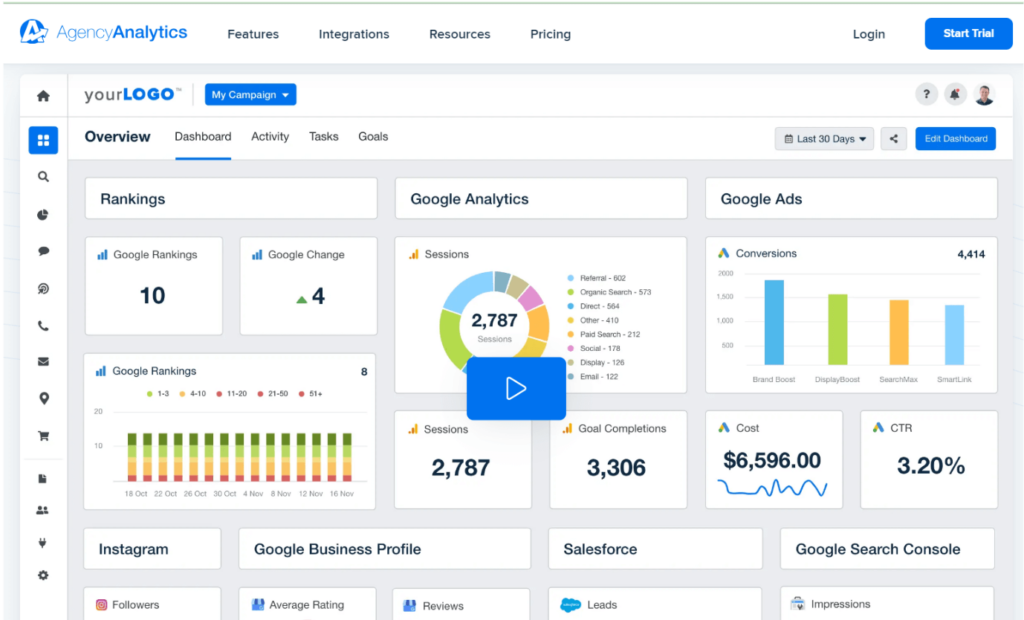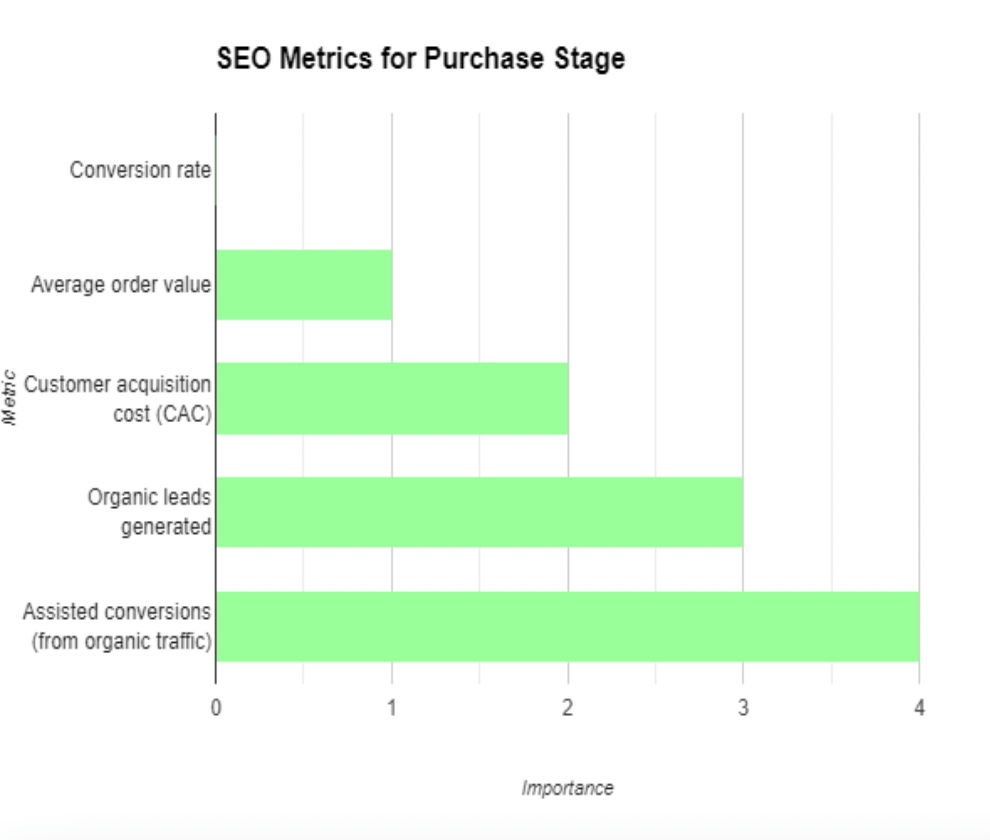One of the most common questions in SEO campaigns is what SEO return on investment (ROI) looks like during and after SEO efforts. Clients don’t just want to see SEO data gathered from agency rank tracking software or any other digital tools. They crave impact on their bottom line.
So, where do you begin?
This article presents an actionable guide to crafting agency SEO reports that help businesses understand their SEO performance and take the required steps for success. We’ll explore the do’s and don’ts of agency SEO reporting and explain why some SEO data can be more noise than insight.
What is SEO Reporting?
SEO reporting is the practice of using digital tools to gather data on SEO performance. For SEO agencies, specifically, SEO reporting analyzes key data points and provides insights into SEO efforts’ return on investment (ROI). This can be used to guide strategic decision-making.
The report can be automated and customized to include various metrics or KPIs, depending on the client’s needs. It is, however, to be delivered regularly (such as weekly or monthly) to track progress over time.
Why is SEO Reporting Important for Marketing Agencies?
Here are a few reasons why every marketing agency needs to prioritize SEO reporting:
1. Fosters Data-driven Decisions (No More Guesswork)
SEO involves countless tweaks and changes. It’s not a set-it-and-forget-it discipline of marketing. Reporting helps you quantify the impact of those changes and separate winning strategies from duds. Imagine A/B testing algorithms without metrics – now that’s SEO without reporting.
2. Identifies Performance Bottlenecks
SEO reports pinpoint areas hindering your website’s visibility. You can see which keywords aren’t ranking well, which pages have poor mobile performance, or where backlinks are lacking.
3. Tracks Progress and Measures ROI
SEO is a long-term investment, and monthly or regular reporting shows if those efforts are paying off in tangible terms. That could mean tracking organic traffic growth, conversion rates from search, and even revenue generated from organic visits.
4. Justifies Resources and Secures Buy-in
Technical teams need resources. Reporting with clear data and impact visuals helps you communicate the value of SEO to stakeholders.
5. Helps Adapt to Algorithm Changes and Iterate Quickly
Search algorithms evolve constantly, and reporting helps you identify trends and adapt your strategy before competitors sweep you off the track. It’s like monitoring network traffic patterns to anticipate spikes and optimize bandwidth allocation.
The Do’s of Agency SEO Reporting
1. Focus on Relevant KPIs
A strong focus on relevant KPIs can help agencies avoid the trap of overflowing SEO reports with unnecessary data or vanity metrics. This helps SEOs provide a clear, accurate representation of the value they bring to their clients.
For example, if the client aims to increase website traffic, the report should focus on metrics such as keyword rankings, organic search traffic, referral traffic, and social media traffic. Organic search traffic refers to visitors who find your website through unpaid methods like a regular Google search, social media, or an online forum.
With a focus on organic search traffic as KPIs, SEO reports can recognize customer journeys and identify the level of brand awareness on search engines after SEO efforts. Here’s an example:
Suppose the client is an e-commerce business with specific keyword targets to rank in top positions in search engines. In that case, the SEO report should showcase the following metrics:
- Ranking progress for those keywords (the search volume data)
- The ranking page of the keyword
- Organic impressions for each
- Click-through rate for each keyword
- Comparison of keyword ranking to competitors
- Average CPC per keyword
Side note: when creating a report, it is essential to showcase the specific snippets that your website ranks for. This will help you determine how much traffic these snippets generate, and help you identify the keywords to focus on for more snippets. Read our blog on rank tracking reports to understand further the key metrics necessary to measure your SEO performance.
2. Use Customizable and Automated SEO Reporting Tools or Templates
One way to simplify the reporting process is to use rank-tracking software that automates rank data collection and integrates it into pre-designed reporting templates. This strategy will help you retain control over design quality and client goals. Here are some of the leading agency rank-tracking software that provides automated search ranking reports:

Keyword.com
Keyword.com’s agency SEO reporting prioritizes data accuracy to help you make informed SEO decisions. It uses a third-party verification tool to ensure the ranking data you receive in our reports is reliable and trustworthy.
- Key features: white labeling options, custom domain, scheduled reports, mobile/desktop rank tracking, and historical data analysis.
- Customization offerings: design reports with custom data visualizations, add client branding, and filter data based on specific keywords and campaigns.
- Automation offerings: schedule automatic report deliveries and set up alerts for significant ranking changes.
AgencyAnalytics
AgencyAnalytics offers automated SEO reporting software that helps streamline agencies’ workflows. The tool provides real-time updates on backlinks, keyword rankings, website analytics, SEO site health, and more in one easy-to-use dashboard and report.

- Key features: Keyword Rank Tracker, Backlink Analytics, Website SEO Audit
- Customization offerings: design custom reports with white-labeled branding, select specific metrics, and create custom dashboards for each client.
- Automation offerings: schedule automatic delivery of keyword ranking reports with data pulled directly from agency rank tracking software.
Google Analytics
Google Analytics tracks and analyzes website traffic in real-time. This includes detailed insights into where visitors are coming from, their devices, and how they interact with your site. Google Analytics allows for the tracking of specific goals, such as form submissions or product purchases, enabling agencies to measure the direct impact of their SEO efforts on business outcomes.
Another key feature of Google Analytics is its customization and integration capabilities. Agencies can create custom reports and dashboards focusing on the metrics most relevant to their SEO goals. This means you can tailor the information presented to suit each client’s specific needs, providing a more personalized and effective reporting experience.
3. Establish a Clear Revenue Attribution Model
A revenue attribution model is a method used to determine which marketing activities or touch points contributed to a specific customer conversion or revenue. In other words, it helps answer the question: “Which marketing efforts are bringing in the most money?”
Don’t assume a linear cause-and-effect relationship between SEO and revenue. Identify the relevant conversion points in your client’s funnel (e.g., leads generated, purchases made) and choose an attribution model that aligns with their business model.
Popular options include last-click, first-click, multi-touch attribution, or custom models based on your data and client’s business model.
Let’s consider this example:
Client: an online clothing retailer focused on sustainable fashion.
Business goal: increase online sales revenue by 15% year-over-year.
Challenge: accurately assess the impact of SEO on revenue, acknowledging the complex customer journey and potential influence of other marketing channels.
Solution:
- Identify Conversion Points
-
- Key conversions: product page views, add-to-cart actions, completed purchases.
-
- Secondary conversions: blog post views, social media engagement from organic traffic, and more.
- Choose an Attribution Model
-
- Multi-touch attribution (e.g., U-shaped model) is ideal, considering the various touchpoints (organic search, social media, email) before purchase.
- Analyze Data
- Use tools like Google Analytics custom segments to analyze revenue and conversion rates for different organic keyword groups and landing pages.
-
- Compare conversion rates and revenue of organic traffic to other channels to isolate SEO’s contribution.
- Report and Share Insights
-
- Visualize data in a dashboard showing revenue generated by organic traffic, contribution margin, and ROI.
-
- Highlight specific SEO optimizations that led to conversion rate increases and revenue uplift (e.g., A/B testing results on product page titles).
- Recommend further SEO strategies based on data insights to optimize key conversion points in the customer journey.
4. Employ Data and Visual Storytelling
You must turn data into a compelling narrative. Don’t just present facts; tell a story with your visuals. SEO reporting is an opportunity to use charts and tables to illustrate the journey of your SEO strategy, highlighting progress and challenges.
Thematic coherence is also crucial here—group metrics by themes or target areas, showcasing how each element contributes to the bigger picture.
For example, instead of presenting a table with various traffic metrics like visits, bounce rate, and conversions, combine metrics in a stacked bar chart by overlaying organic traffic with paid traffic to visually compare their impact on overall website visits.
Also, you can use a funnel chart to track user journeys from landing page to conversion, highlighting potential drop-off points and areas for optimization.
5. Highlight the Value of Content Assets
SEO efforts often produce valuable content assets like blog posts, infographics, and white papers. Show how these assets contribute to long-term organic performance and reduce reliance on paid channels.
A good practice is to track backlinks acquired to high-quality content pieces, lead generation forms submitted from organic traffic landing pages, and brand mentions related to published content.
How do these content assets translate to cost savings over time?
You can present calculations on cost-efficiency by comparing the organic growth to the costs of acquiring traffic through paid advertising channels like PPC or social media ads.
The Don’ts of SEO Agency Reporting
1. Avoid Vanity Metrics
Not all metrics translate to ROI. Some metrics, like keyword ranking or website traffic, don’t directly translate to increased revenue or conversions. Of course, they’re valuable indicators of SEO effectiveness and have key roles in overall SEO efforts. However, focusing solely on them might give a partial picture of ROI.
It’s essential to understand the goals of each metric for the SEO efforts to avoid sharing vanity metrics with clients. Doing this could mean identifying SEO metrics for customer journeys or simply focusing on customer journey optimization.
Using Bard, we generated a graph illustrating SEO metrics for four customer journey stages. This categorization could help prioritize metrics that matter during agency SEO reporting.
- Awareness
- Consideration
- Purchase
- Retention




2. Don’t Neglect (or Ignore) the Competitors
Successful SEO campaigns involve standing on the shoulders of giants. That means benchmarking against small or big competitors to add context and showcase progress relative to industry standards. You can only reveal whether your progress is exceptional, average, or lagging by including competitors’ data.
Imagine reporting a 10% increase in organic traffic and the competitors saw a 20% jump: your client is definitely behind.
Analyzing competitors’ strengths and weaknesses exposes gaps in their strategies.
You can leverage these insights to create differentiated approaches for your client, targeting underserved keywords or capitalizing on missed content opportunities.
For instance, the competitors’ older blog posts may be successful but have not been updated recently. This presents a good opportunity to give those ideas a fresh perspective on your client’s blog.
Beyond recognizing content gaps, keyword ranking reports, an essential part of competitor analysis, can reveal products or services that your competitors are not offering but are important to your audience.
In addition, demonstrating how your tactics address specific competitor moves in your SEO reports reinforces their value. Did you switch to long-tail keywords after noticing a competitor dominated broad terms? Showcase the improved rankings and targeted traffic to justify your approach.
3. Don’t Be a Black Box, Be Transparent
How can you avoid being among the SEO agencies that promise quick and easy results and even guarantee unrealistic rankings or traffic increases?
To achieve their results, they employ black hat SEO techniques. This often leads to disappointment and distrust when clients don’t see the promised results, as SEO is a complex and long-term process. It is good to highlight wins, but don’t shy away from challenges.
Explain setbacks and propose solutions in your SEO reports. Provide context and an action plan when reporting on an experiment or tactic that did not perform as expected. Simply stating that something failed without any clear explanation or proposed solutions can be unhelpful and discouraging.
For example, instead of simply stating, “Experiment X failed,” delve deeper. Explain the specific results you observed, how they deviated from expectations, and the contextual factors that might have influenced them.
Was it a sudden algorithm update? Unexpected competitor activity? An inaccurate assumption about your target audience?
Here is a template:
“Our experiment to increase organic traffic through guest blogging on high-authority sites delivered mixed results. While we secured 20+ backlinks/placements on relevant websites, the traffic uplift was lower than anticipated. We suspect this might be due to increased competition for guest blogging opportunities and user behavior shifting towards social media content discovery.”
Don’t end your report there. Outline a clear and actionable plan to address the identified issues. For example, you can state:
“Based on these insights, we propose to focus on guest blogging opportunities with strong editorial control. To diversify our backlink profile, we’ll also explore alternative link-building strategies, such as broken link building and influencer outreach.”
Increase Your Clients’ SEO Performance with Keyword.com Rank Tracker
Plan and execute your agency’s SEO strategy in months, not years, with Keyword.com!
Tracking rankings for hundreds to thousands of keywords can be time-consuming and overwhelming. You need a tool that cuts time spent in half and accurately uncovers blindspots so that you can quickly execute your campaign.
Keyword.com tracks thousands of keywords daily with sophisticated analysis to climb to the top of SERPs. This agency keyword tracking tool allows unlimited projects and users, offering several keyword tracking options with automated search ranking reports. Most importantly, users can remove any mention of keyword.com and change it to their logo or brand to build trust with their clients.
Sign up for Keyword.com to share your wins with your clients and prove that your SEO strategies are working.
